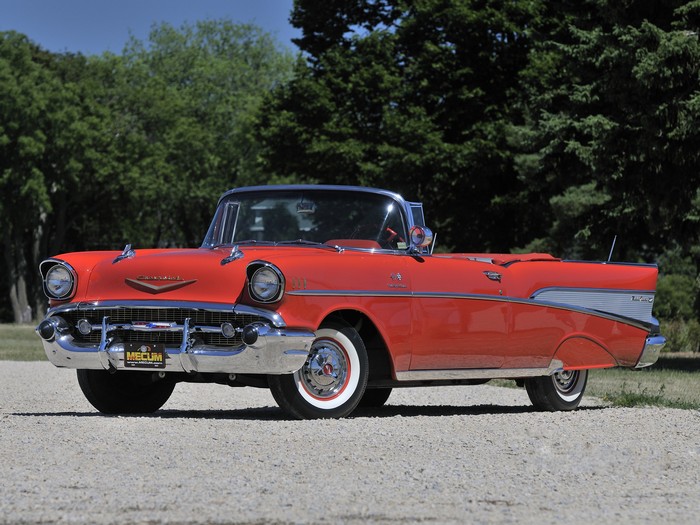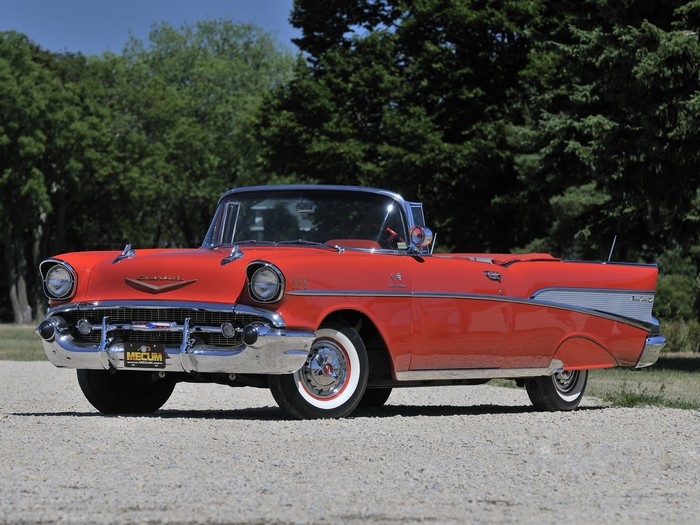
This fabulously restored 1957 Chevrolet Bel Air convertible has it all: gorgeous Matador Red paint, full dress inside and out and the rare FJ-code 283/250-hp fuel-injected V8 and Powerglide automatic drivetrain.
With its fender skirts, optional extra rocker and fender-skirt bright trim, dual antennas, driver’s spotlight mirror, spinner wheel covers, wide whitewalls and Continental kit, the car has the looks to back up Chevy’s top-performing production engine.
Other features include power steering, power top, tissue dispenser, in-dash clock and Wonderbar radio.
SCM Analysis
Detailing
| Vehicle: | 1957 Chevrolet Bel Air Fuelie convertible |
| Years Produced: | 1955–57 |
| Number Produced: | 68 (250-hp ’57 Fuelie convertibles) |
| Original List Price: | $4,142 |
| SCM Valuation: | $80,000–$165,000 (fuel injection) |
| Tune Up Cost: | $275 |
| Distributor Caps: | $31 |
| Chassis Number Location: | Plate on the left front door hinge pillar |
| Engine Number Location: | Pad on front of block below right cylinder head |
| Club Info: | Tri Chevy Association |
| Website: | www.trichevy.org |
| Alternatives: | 1957 Ford Fairlane F-code, 1957 Dodge D-500, 1957 Plymouth Fury |
| Investment Grade: | A |
This 1957 Chevrolet Bel Air Fuelie convertible, Lot 213, sold for $127,200, including buyer’s premium, at Mecum’s Monterey auction in Monterey, CA, on August 17, 2012.
For decades, Chevrolet and Ford battled in the showroom for the title of best-selling brand in America. By 1956, that brawl had spilled out onto racetracks across the nation.
As the popularity of stock-car racing spread in the early 1950s — NASCAR in the Deep South and Mid-Atlantic states, AAA/USAC in the Midwest — manufacturers became increasingly involved. While the championships the Hudson Hornet earned from 1951 to 1954 did little to save that company, the dominance of the Hemi-powered Chrysler 300s in 1955 and 1956 served notice that Chrysler was no longer a company building boring automobiles. Both Chevrolet and Ford joined the fray in 1956.
Competition and the power revolution
In advance of the ’57 racing season, Chevrolet made this modest announcement: “Chevy explodes the biggest auto news of 1957 — Fuel Injection! Ramjet fuel injection, optional at extra cost on any Chevrolet model, offers constant-flow port injection, choice of 250 or 283 hp.”
Chevrolet also set up the Southern Engineering and Development Company (SEDCO), a company led by former Hudson racing director Vince Piggins, to build a number of race cars based on the Chevy 150 sedan. Dubbed the “Black Widows,” the stripped-down sedans were powered by Chevy’s new 283-hp Fuelie.
Not to be outdone, Ford countered with a special Fairlane of their own, powered by the new F-code 312-ci V8 equipped with a McCulloch supercharger. Ford’s president, Robert McNamara, ordered 100 F-code cars to be built to counter Chevy’s performance threat.
Ironically, the Black Widow Chevys and the F-code Fords got to race only once — NASCAR laid down new rules to stop the madness on February 20, 1957, mandating just one 4-barrel carburetor.
Outside of stock car racing, fuel-injected Chevys competed in the 1957 Daytona Speed Weeks. In Class 4 (213 to 259 ci) they won the first three places in the flying mile; in Class 5 (259 to 305 ci) they took 33 out of 37 places. Then in March 1957, fuel-injected Corvettes finished 1-2 in the GT class at the Sebring 12 Hours, Corvette’s first victory on the international stage.
Hotter performers, slower sellers
This was the era of “Win on Sunday, sell on Monday.” But Chevrolet’s expensive Rochester FI systems were slow to be accepted in the showrooms. At the end of 1957, a total of 1,530 units were installed in full-sized Chevys, mostly in “Sweet, Smooth, and Sassy” Bel Air coupes. But there were a few convertibles and Nomads with the option. Corvettes received another 1,040, while 630 were installed on Pontiac’s flagship Bonneville.
Most Chevys and Corvettes had the 283-hp version, with 10.5:1 compression, mechanical lifters, wild cam, and 3-speed manual transmission. Less popular was the 250-hp fuel-injected option, with lower compression, hydraulic lifters and cam, and the 2-speed Powerglide automatic. That’s the powerplant in our featured Bel Air convertible.
I’ve never understood the logic behind the 250-hp Fuelie. If you’re going to spend $484 for an engine option, around 20% of the base price, wouldn’t you buy the top performance version? That’s what most Chevy and Corvette buyers did.
But in its defense, the 250-hp V8 is a much nicer option for everyday driving, as it idles smooth and is easier to start. Yet anytime the owner of one of these cars opened the hood, they instantly had the same bragging rights as the higher-spec cars, because externally, both engines basically look the same.
Out of 1,530 full-sized ’57 Chevys with fuel injection, just 68 250-hp Bel Air convertibles were built. So our subject car is a rare machine, even if it isn’t the highest-performing example from its era.
Fins, Fuelie units and Americana
Perhaps no American automobile is more iconic than the ’57 Bel Air. The design itself it pure 1950s — straight out of Harley Earl’s fintastic GM styling department, and complete with gun-sight hood ornaments, extensive chrome, and of course, those fins. These cars were stylish, fast and affordable, and because of that, their collector value has traditionally been high among buyers who grew up in the era when ’57s were the cruisers of choice. Add fuel injection, and you have a rare, highly desirable combination.
This car is pure Americana — to some, it’s a fond memory, and to others, it’s a car-culture icon. There’s collector value in both, but the dollar amounts placed on them aren’t the same.
In 2010 a fuel-injected Bel Air sedan from RM’s sale of the Milt Robson Collection sold for $315,000, but that was an exceptional car from a well-known collection. 283-hp convertibles have sold for as much as $209k, and 250-hp ragtops for $167k. In 2011, we even saw a carbureted Bel Air convertible sell for $121k. Compared with those sales, this $127k sale of a well-optioned and well-restored 250-hp Bel Air convertible, painted the obligatory Matador Red, looks like a good deal.
But it could be a sign of the times, as we’re seeing a slow descent in value from these cars’ long-lasting value peak. Generally, a lot of collectors who were willing to pay up for these high-option examples aren’t buying anymore, but selling. And the buyers who have replaced them don’t have the same personal connection to these cars — they’re buying the icon rather than the memory. That transfers to the bottom line.
But if you’re a Tri-Five lover, this is really the best spec for a drivable example, even with that Powerglide auto. And $127k for a car done to this level is smack on the current market level. I’d call it decently bought. After all, it’s a “Sweet, Smooth, and Sassy” ragtop with an iconic shape and the soul of a racing champion.
(Introductory description courtesy of Mecum Auctions.
